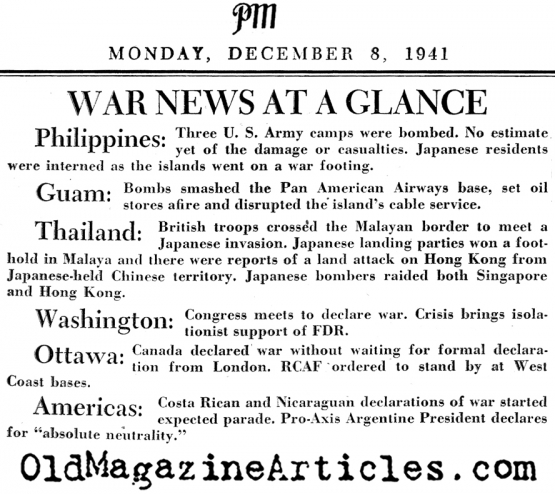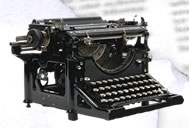Attached is an eyewitness account of the Pearl Harbor attack as relayed to family members in a letter written home a few weeks after the assault:
"The noise was like ten thousand factories gone nuts....Quicker than I can tell you, a bomb blows up the barracks with the gang in it, a ship explodes in front of me, a hangar goes up in flames..."
The very next day President Roosevelt stood before the microphones in the well of the U.S. Capitol and asked Congress to declare war against the Empire of Japan; CLICK HERE to hear about the reactions of the American public during his broadcast...
Pearl Harbor Christmas: A World at War, December 1941
Click here to read about the Battle of Midway.
"The Navy's own story of the events that led up to Pearl Harbor now can be drawn from top-secret documents placed before the Pearl Harbor Committee. These documents show that misunderstanding, inadequate co-ordination and other factors helped the Japanese surprise attack, even though the Navy was almost certain a Pacific war was coming."
"It now becomes apparent that the U.S. Government, long before Pearl Harbor, knew Tokyo's war plans almost as thoroughly as did the Japanese. To all practical purposes, Washington had ears attuned to the most intimate, secret sessions of Japan's cabinet."
A year and a half before the Pearl Harbor attack, Naval Intelligence sold a Japanese agent some bogus plans of the naval installation - more about this can be read here.
To get a sense as to how thoroughly the Japanese diplomatic codes had been compromised, we recommend that you read the attached article. It is composed entirely of the chit-chat that took place between the government functionaries in Tokyo, their diplomats in Washington, their spies in Hawaii and their representatives in Berlin.
The article winds up explaining that the one vital communication that contained the information regarding the day of Japan's attack was not translated until December 8.
Recognizing that responsible commanders must always assume the blame for the failings within their respective domains, former U.S. General George C. Marshall and General Leonard T. Gerow stood up and claimed responsibility for leaving Pearl Harbor vulnerable to Japanese attack. Marshall had been FDR's Army Chief-of-Staff since the Autumn of 1939 and Gerow had been serving as executive officer of the War Plans Division at the time of the sneak attack - however,
To read this article is to understand that these men were responsible for Pearl Harbor's lack of preparedness...
When this article went to press the Pear Harbor attack was already over a year old - and like the articles that came out in '41, these two pages capture much of the outrage that was the general feeling among so many of the American people. The article serves to give an account as to how the ships that were damaged that morning have largely recovered and were once again at sea (excluding the
Arizona).
Five months after the Pearl Harbor attack the United States Navy defeated the Imperial Japanese Navy in the Coral Sea, click here to read about it...
"Cordell Hull, aging ex-Secretary of State, snapped back in reply to the section of the report which had implied that he was partly at fault for the disaster because his actions had precipitated a crisis. In a hitherto unpublished letter, Hull pointed out
(1.) that he had personally advised the general staff on 25 November, 1941 that war was imminent, and (2.) that his final negotiations had not included any ultimatum that was a spark to set off the Asiatic conflagration."
One morning a 17 year-old boy exclaimed to his amateur aviator father: "Let's fly around the island, Dad!" - this article wouldn't seem worthy of appearing on the internet if they lived on Nantucket or Martha's Vineyard, but the island in question was Honolulu and the morning was December 7, 1941...

"Out of the Pearl Harbor investigation last week came a decoded telephone conversation made on November 27, 1941, two weeks before the Japanese attacked, that had all the elements of a penny-dreadful spy thriller... On the Washington end of the trans-pacific phone call was Saburo Kurusu, Japanese special envoy to the United States; on the Tokyo end, Admiral Yeisuke Yamamoto, Chief of the American Division of the Japanese Foreign Office."
The conversation guaranteed Yamamoto that the negotiations between the two sides were proceeding smoothly and that the attack on Pearl Harbor would be a surprise.
"Into the records of the Pearl Harbor investigating committee last week went a little-noticed document that added new mystery to the disaster of December 7, 1941:"
"Four months before the enemy struck, the Army and Navy air command at Pearl Harbor drew up a joint defense plan which correctly forecast the hour, the direction, the size of the force and the strategy by which the Japs actually attacked."
One year after the Japanese attack on Pearl Harbor the Navy released its report to the press with updates on all the various repairs that were put into effect.
- from Amazon:
Ghosts of Honolulu: A Japanese Spy, A Japanese American Spy Hunter, and the Untold Story of Pearl Harbor
A year after the Pearl harbor attack, one of the PM journalists recalled for their readers how many Americans in the lower 48 had heard the news on the radio that evening.
Six months before Japan's devastating assault on Pear Harbor came this article concerning how remarkable the Navy's defensive measures were and how unlikely it would be if the installation was ever to be attacked. A large part of the article concerned how overwhelmingly Japanese the Oahu population was, and the many steps taken by the Army and Navy to keep them off-base. How terribly unimaginative of them to think that Japanese Naval Itelligence wouldn't think to farm-out spying to an Englishman like
Frederick Rutland - which they did.
"Don't believe that the Japanese ordered their dawn assault only yesterday. The fact is that they ordered it not days ago but weeks ago. While Japan's special envoy, Saburo Kurusu, was busy talking in Washington, the ships that were to attack us were already on their way. While he was staling and waiting 'for instructions', they were getting into position. More than that: they had their orders before Kurusu even started talking."
"The news of [the Pearl Harbor] attack broke out at a time on Sunday afternoon when a comparatively few newspapers in the U.S.A. were being published (there were no evening papers on sunday). The result was that the nation learned of the war and its immediate developments almost entirely by radio. The National Broadcasting system held the bulletin for a few minutes, and at 2:30 gave the news simultaneously to its Red and Blue networks, and subsequently to the whole world over its international short-wave system."
Listed herein are 17 events that transpired between the U.S. diplomatic corps and their opposite numbers representing the Empire of Japan.
"The German and Italian propaganda ministries did their customary sister act today, shrieking in unison that it was Franklin Delano Roosevelt who started the war in the Pacific. But they didn't accuse the President of bombing Pearl Harbor."
